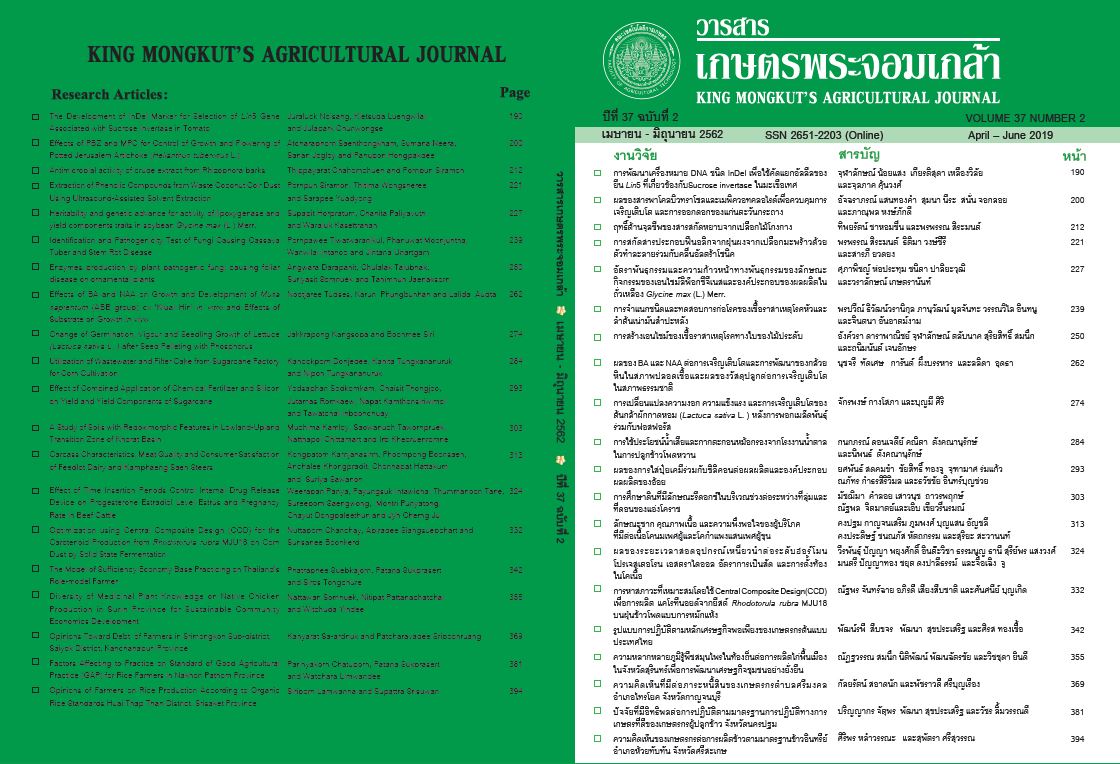การสกัดสารประกอบฟีนอลิกจากฝุ่นผงจากเปลือกมะพร้าวด้วยตัวทำละลาย ร่วมกับคลื่นอัลตร้าโซนิค
Main Article Content
บทคัดย่อ
งานวิจัยนี้ได้ทำการสกัดแยกสารในกลุ่มฟีนอลิกจากฝุ่นผงจากเปลือกมะพร้าวผลิตผลพลอยได้จาก
กระบวนการแปรรูปมะพร้าวเพื่อสร้างมูลค่าเพิ่ม โดยทำการหาสภาวะที่เหมาะสมในการสกัดสารประกอบฟีนอลิกจาก
ตัวอย่างโดยใช้ตัวทำละลายร่วมกับคลื่นอัลตร้าโซนิคช่วยเพิ่มประสิทธิภาพการสกัด ในกระบวนการสกัดได้ศึกษา
3 ปัจจัยหลักที่มีผลต่อการสกัด ได้แก่ ชนิดของตัวทำละลาย อุณหภูมิ และระยะเวลาในการสกัด จากผลการทดลอง
พบว่าสภาวะที่เหมาะสมในการสกัดสารประกอบฟีนอลิกจากตัวอย่างโดยคลื่นอัลตร้าโซนิค คือ การสกัดโดยใช้ตัวทำ
ละลายเอทานอลความเข้มข้นร้อยละ 50 โดยปริมาตร ที่อุณหภูมิ 30 องศาเซลเซียส เป็นเวลา 120 นาที ซึ่งที่สภาวะ
นี้ให้เปอร์เซ็นต์ผลผลิตของสารสกัดร้อยละ 29.57 ของน้ำหนักแห้ง ปริมาณฟีนอลิกทั้งหมดที่สกัดได้เท่ากับ
951.33 ไมโครกรัมสมมูลของกรดแกลลิกต่อกรัมของน้ำหนักตัวอย่างแห้ง เมื่อทดสอบฤทธิ์ในการต้านอนุมูลอิสระของ
สารสกัดหยาบที่ได้ พบว่ามีประสิทธิภาพในการเป็นสารต้านอนุมูลอิสระที่ดี โดยมีความเข้มข้นที่กำจัดอนุมูลอิสระได้
ร้อยละ 50 (IC50) จากวิธี DPPH เท่ากับ 362.77 ไมโครกรัมต่อมิลลิลิตร และจากวิธี ABTS เท่ากับ11.96 ไมโครกรัม
ต่อมิลลิลิตร เทียบกับน้ำหนักสารสกัดหยาบ
Article Details
วารสารเกษตรพระจอมเกล้า
เอกสารอ้างอิง
มะพร้าวจังหวัดประจวบคีรีขันธ์. ว. เกษตรพระจอมเกล้า 32(3): 45-51.
วรัญญา วงศ์วานิช และกิตติชัย บรรจง. 2559. ปัจจัยที่มีผลต่อการสกัดน้ำมันเมล็ดองุ่นด้วยวิธีการแช่และการใช้คลื่นเสียงความถี่สูง
ช่วยสกัด. ว. เกษตรพระจอมเกล้า 34(3): 9-21.
Chotimarkon, C., S. Benjakul and N. Silalai. 2008. Antioxidant components and properties of five long-grained rice bran
extracts from commercial available cultivars in Thailand. Food Chem. 111: 636-841.
Etim, U.J., S.A. Umoren and U.M. Eduok. 2016. Coconut coir dust as a low cost adsorbent for the removal of cationic dye
from aqueous solution. J. Saudi Chem. Soc. 20: S67–S76.
Hagerman, A.E., K.M. Riedl, G.A. Jones, K.N. Sovik, N.T. Ritchard, P.W. Hartzfeld and T.L. Riechel. 1998. High molecular
weight plant polyphenolics (tannins) as biological antioxidants. J. Agric. Food Chem. 46: 1887-1892.
Israel, A.U., R.E. Ogali, O. Akaranta and I.B. Obot. 2011. Extraction and characterization of coconut (Cocos nucifera L.)
coir dust. Songklanakarin J. Sci. Technol. 33(6): 717-724.
Murray, J.C., J.A. Burch, R.D. Streilein, M.A. Lannacchione, R.P. Hall and S.R. Pinnell. 2008. A tropical antioxidant solution
containing vitamins C and E stabilized by ferulic acid provides protection for human skin against damage caused
by ultraviolet irradiation, J. Am. Acad. Dermatol., 59: 418-425.
Olajuyigbe, O.O. and A.J. Afolayan. 2011. Phenolic content and antioxidant property of the bark extracts of Ziziphus mucronata
Willd. subsp. mucronata Willd. BMC Complement. Altern. Med., 130(11): 1-8.
Re, R., N. Pellegrini, A. Proteggente, A. Pannala, M. Yang and C. Rice-Evans. 1999. Antioxidant activity applying an improved
ABTS radical cation decolorization assay. Free Radic. Biol. Med., 26: 1231-1237.
Rodrigues, S. and G.A.S. Pinto. 2007. Ultrasound extraction of phenolic compounds from coconut (Cocos nucifera) shell
powder. J. Food Eng. 80: 869-872.
Rodrigues, S., G.A.S. Pinto and F.A.N. Fernandes. 2008. Optimization of ultrasound extraction of phenolic compounds from
coconut (Cocos nucifera) shell powder by response surface methodology. Ultrason. Sonochem. 15: 95-100.
Singleton, V.L. and J..A. Rossi. 1965. Colorimetry of total phenolics and phosphomolybdicphosphotungstic acid reagents.
Am. J. Enol. Vitic. 6: 144-158.
Siramon, P. and Y. Ohtani. 2007. Antioxidative and antiradical activities of Eucalyptus camaldulensis leaf oils from Thailand.
J. Wood Sci. 53(6): 498-504


